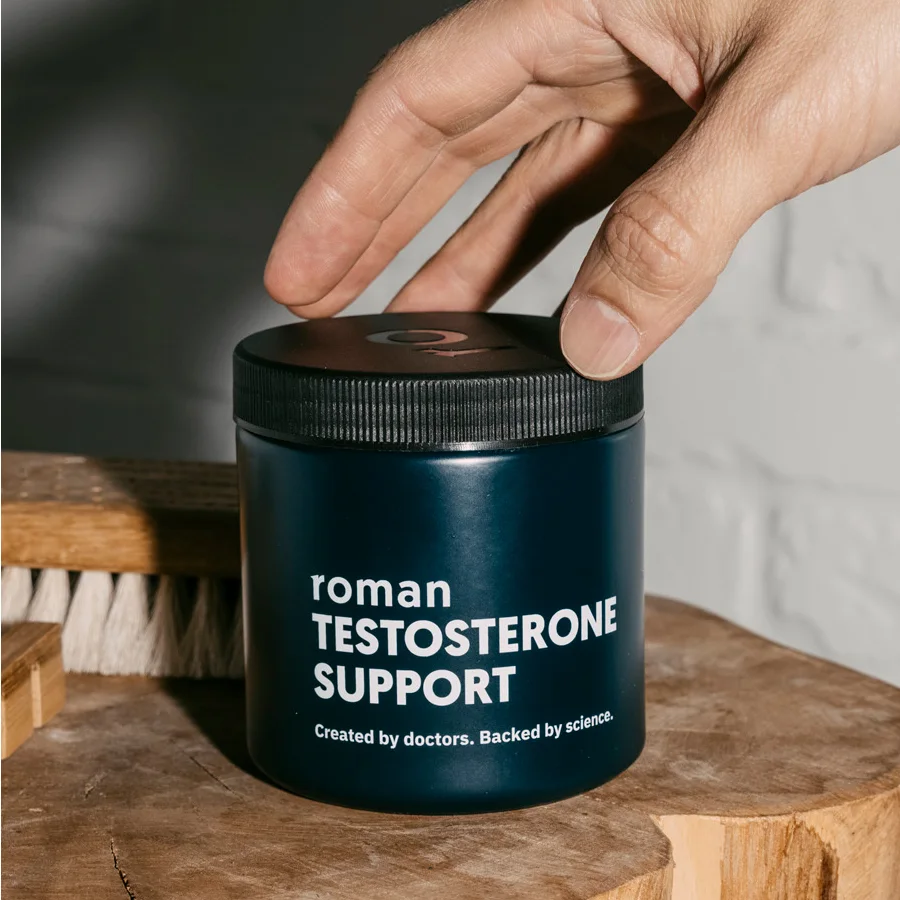Here's what we'll cover
Here's what we'll cover
Here's what we'll cover
You might have heard testosterone replacement therapy (TRT) touted as a cure-all for the broadest of symptoms. "Tired? Stressed? Low sex drive? Moody? Ask your doctor about TRT!" But the truth about testosterone is more complex than that, and there are real risks associated with testosterone replacement therapy.
If you experience any of the aforementioned symptoms of low testosterone (low T), you may wonder—what is TRT? TRT is not a panacea for everything that could be wrong with a man’s health. Continue reading to learn all about testosterone replacement therapy.
What is testosterone?
Testosterone is a sex hormone responsible for many functions in the body. It's present in men and women, but men naturally have higher levels. Testosterone contributes to muscle growth and development, bone health, libido (sex drive), and maintaining red blood cell levels. It may also play roles in improving mood and cognitive function. Testosterone gives men characteristic traits like deeper voices, facial hair, penis and testicle development, and sperm production.
What are the symptoms of low testosterone?
Commonly, testosterone levels decline as a man ages. According to some studies, testosterone levels fall about 1% to 2% a year, starting around age 40 (Miah, 2019).
Besides the natural decline with age, other causes of low testosterone, or low T, can include sleep problems, some infections like HIV, diabetes, obesity, and more. Men with low testosterone levels in adulthood often experience decreased sex drive, erectile dysfunction (including less frequent morning erections), fatigue, loss of muscle mass, increased fat gain, anemia (low blood cell count), and osteoporosis (weak bones). Keep in mind that many other health conditions can cause these symptoms—ranging from depression to iron deficiency—so if you’re experiencing these signs, talking to a healthcare provider or taking a blood test to check your T levels is a good first step.
What is TRT?
If you've been diagnosed with low T or hypogonadism, your healthcare provider may decide to prescribe testosterone replacement therapy (TRT) for you. Testosterone replacement therapy aims to restore your testosterone to normal, healthy levels by replacing the missing testosterone with pharmaceutically manufactured testosterone. Also called androgen replacement therapy, TRT can come in many different forms (more on that below).
To diagnose low T, testosterone is usually tested twice, early in the morning, when your levels are highest. Two low readings (<300 ng/dL), along with clinical symptoms, are usually required for a diagnosis.
Your healthcare provider may also test your levels of other hormones, such as follicle-stimulating hormone (FSH) and luteinizing hormone (LH), to figure out whether another condition might be causing your low testosterone. Some men with low T will need special imaging tests to fully understand what is going on.
How can you get TRT?
There are several ways to get TRT; your best option depends on your medical needs and preference. Here are the main ways testosterone replacement therapy is delivered:
Topical: One way to get testosterone is topically (through the skin) in the form of gels, patches, creams, and solutions. The main advantage of topical TRT is that it’s usually absorbed slowly, so levels in the blood are more stable. The disadvantages vary from product to product. Gels and solutions can have an unpleasant odor and could transfer to other people if touched after application. Patches can cause skin irritation and rashes.
Injections: There are several injection formulations of testosterone. Some are injected deep into the muscle, while others are injected just under the skin. Depending on the formulation, an injection lasts for a week to a couple of months. With injections, testosterone levels fluctuate significantly, resulting in fluctuating mood, sex drive, and energy levels. Injections also make it more difficult for your healthcare provider to adjust your dose if it's too high or low.
Buccal (cheek): A buccal testosterone system is also available. It's a medication designed to stick to your gums. A disadvantage is that it can irritate your gums and mouth.
Pellets: Testosterone pellets are plastic pellets implanted under the skin in the hips. There, they slowly release testosterone for 3 to 6 months. The main disadvantage here is the obvious need to implant the pellets in a healthcare provider's office.
Oral tablets: Testosterone tablets are available but usually not recommended by healthcare providers. There have been reports of liver damage associated with long-term use (Westaby, 1977). Oral tablets also come with a warning about possibly causing high blood pressure and cardiovascular events (heart attacks or strokes).
Nasal gel: A new product is a nasal testosterone gel. You apply this gel to the inside of your nose. An advantage of the nasal gel is that the risk of transferring it to someone else is low, unlike other gels. A disadvantage is it must be applied three times a day in each nostril. Some people may get runny noses and nose bleeds. This is a relatively new treatment, and some healthcare providers might suggest other forms of TRT that have been studied longer over the nasal gel.
Most healthcare providers typically suggest topical gels first because they give you stable, normal testosterone levels and are relatively easy to use. A study of patient satisfaction with TRT didn’t show significant differences in satisfaction between gels, injections, or pellets (Kovac, 2014).
Benefits of TRT
You’ve read about some disadvantages, but what are some potential benefits of TRT? To answer this question, the National Institutes of Health (NIH) sponsored a series of coordinated trials to evaluate TRT, running for a year.
What did the trials find? Testosterone was helpful for mood and depressive symptoms, mild to moderate anemia, bone density and strength, and all measures of sexual function (Snyder, 2018). They also found that testosterone allowed participants to walk slightly further (a measure of exercise tolerance). Other studies have found that TRT can decrease body fat and increase lean muscle mass (Skinner, 2018; Fui, 2016).
Notably, TRT did not improve energy or cognitive function.
Who shouldn't get TRT?
For some men with low T who also have pre-existing health conditions, the risk of severe side effects from TRT is higher than for others. In these cases, a healthcare provider might decide that TRT isn’t right for you. These pre-existing health conditions include:
A history of prostate or breast cancer: Testosterone may cause prostate cancers to advance faster. Testosterone can also be converted to estradiol, which may cause breast cancers to grow.
Severe lower urinary tract symptoms (LUTS): Lower urinary tract symptoms include frequent, urgent needs to urinate, producing less urine than usual, pain or burning when urinating, difficulty starting to urinate, straining during urinating, difficulty emptying your bladder, pain with ejaculation, discharge from the urethra, and discomfort in the genitals, groin, lower abdomen, or lower back. These symptoms are frequently the result of having an enlarged prostate. Again, TRT can cause the prostate to grow, worsening these symptoms.
Severe and untreated sleep apnea: Testosterone can worsen obstructive sleep apnea. If your sleep apnea is treated, you may be able to get TRT.
Conditions that put you at a higher risk for blood clots: This can include erythrocytosis, a condition where you have too many red blood cells. Testosterone can encourage the production of more red blood cells, which may increase your risk of having a blood clot.
Uncontrolled heart failure: Testosterone can cause more fluid to be retained in your body and can worsen heart failure.
Ultimately, a healthcare provider will decide for or against TRT based on a man’s individual risk profile and whether they want to have a child in the near term. TRT keeps the body from creating new sperm, which can cause fertility loss.
Side effects of TRT
Getting TRT for low T is not risk-free.
In addition to the risks listed above, TRT can cause acne and oily skin, enlarged breast tissue (gynecomastia), and elevated cholesterol. There’s also a possible increased risk of developing benign prostatic hyperplasia (BPH), as testosterone can drive prostate growth and increased prostate-specific antigen (PSA). Other possible risks include cardiovascular problems, including heart attacks or strokes, but more research is needed here (Fernández-Balsells, 2010; Grech 2014).
In summary, while testosterone replacement therapy is an effective treatment for low T, it’s not for everyone. If you suspect you have low T or are concerned about your T levels, the first step is getting a testosterone test to see if your levels are normal. Depending on your results, your healthcare provider will help you develop a safe treatment plan that’s right for you.
DISCLAIMER
If you have any medical questions or concerns, please talk to your healthcare provider. The articles on Health Guide are underpinned by peer-reviewed research and information drawn from medical societies and governmental agencies. However, they are not a substitute for professional medical advice, diagnosis, or treatment.
References
Banks, W. A., Morley, J. E., Niehoff, M. L., & Mattern, C. (2009). Delivery of testosterone to the brain by intranasal administration: Comparison to intravenous testosterone. Journal of Drug Targeting, 17 (2), 91–97. doi:10.1080/10611860802382777. Retrieved from https://www.ncbi.nlm.nih.gov/pubmed/19089688
Bhasin, S., Brito, J. P., Cunningham, G. R., et al. (2018). Testosterone therapy in men with hypogonadism: An Endocrine Society* Clinical Practice Guideline. The Journal of Clinical Endocrinology & Metabolism, 103 (5), 1715–1744. doi:10.1210/jc.2018-00229. Retrieved from https://www.ncbi.nlm.nih.gov/pubmed/29562364
Elejalde-Ruiz, A. (2018). AbbVie nears settlement in thousands of lawsuits alleging harm by testosterone drug AndroGel. Chicago Tribune . Retrieved from https://www.chicagotribune.com/business/ct-biz-abbvie-androgel-testosterone-lawsuits-settlement-0915-story.html
Fernández-Balsells, M. M., Murad, M. H., Lane, M., et al. (2010). Adverse effects of testosterone therapy in adult men: A systematic review and meta-analysis. The Journal of Clinical Endocrinology & Metabolism, 95 (6), 2560–2575. doi:10.1210/jc.2009-2575. Retrieved from https://www.ncbi.nlm.nih.gov/pubmed/20525906
Fui, M. N. T., Prendergast, L. A., Dupuis, P., et al. (2016). Effects of testosterone treatment on body fat and lean mass in obese men on a hypocaloric diet: a randomised controlled trial. BMC Medicine, 14,
doi:10.1186/s12916-016-0700-9. Retrieved from https://www.ncbi.nlm.nih.gov/pubmed/27716209
Grech, A., Breck, J., & Heidelbaugh, J. (2014). Adverse effects of testosterone replacement therapy: an update on the evidence and controversy. Therapeutic Advances in Drug Safety, 5 (5), 190–200. doi: 10.1177/2042098614548680. Retrieved from https://www.ncbi.nlm.nih.gov/pubmed/25360240
Kovac, J. R., Rajanahally, S., Smith, R. P., et al. (2014). Patient satisfaction with testosterone replacement therapies: The reasons behind the choices. The Journal of Sexual Medicine, 11 (2), 553–562. doi:10.1111/jsm.12369. Retrieved from https://www.ncbi.nlm.nih.gov/pubmed/24344902
Miah, S., Tharakan, T., Gallagher, K. A., et al. (2019). The effects of testosterone replacement therapy on the prostate: a clinical perspective. F1000Research, 8 , F1000 Faculty Rev-217. doi:10.12688/f1000research.16497.1. Retrieved from https://www.ncbi.nlm.nih.gov/pmc/articles/PMC6392157/
Skinner, J. W., Otzel, D. M., Bowser, A., et al. (2018). Muscular responses to testosterone replacement vary by administration route: a systematic review and meta-analysis. Journal of Cachexia, Sarcopenia and Muscle, 9 (3), 465–481. doi:10.1002/jcsm.12291. Retrieved from https://www.ncbi.nlm.nih.gov/pubmed/29542875
Snyder, P. J., Bhasin, S., Cunningham, G. R., et al. (2018). Lessons from the testosterone trials. Endocrine Reviews, 39 (3), 369–386. doi:10.1210/er.2017-00234. Retrieved from https://www.ncbi.nlm.nih.gov/pubmed/29522088
U.S. Food & Drug Administration (FDA). (2018). FDA Drug Safety Communication: FDA cautions about using testosterone products for low testosterone due to aging; requires labeling change to inform of possible increased risk of heart attack and stroke with use. Retrieved from https://www.fda.gov/drugs/drug-safety-and-availability/fda-drug-safety-communication-fda-cautions-about-using-testosterone-products-low-testosterone-due
Westaby, D., Paradinas, F., Ogle, S., et al. (1977). Liver damage from long-term methyltestosterone. The Lancet, 2 (8032), 262–263. doi:10.1016/s0140-6736(77)90949-7. Retrieved from https://www.ncbi.nlm.nih.gov/pubmed/69876










